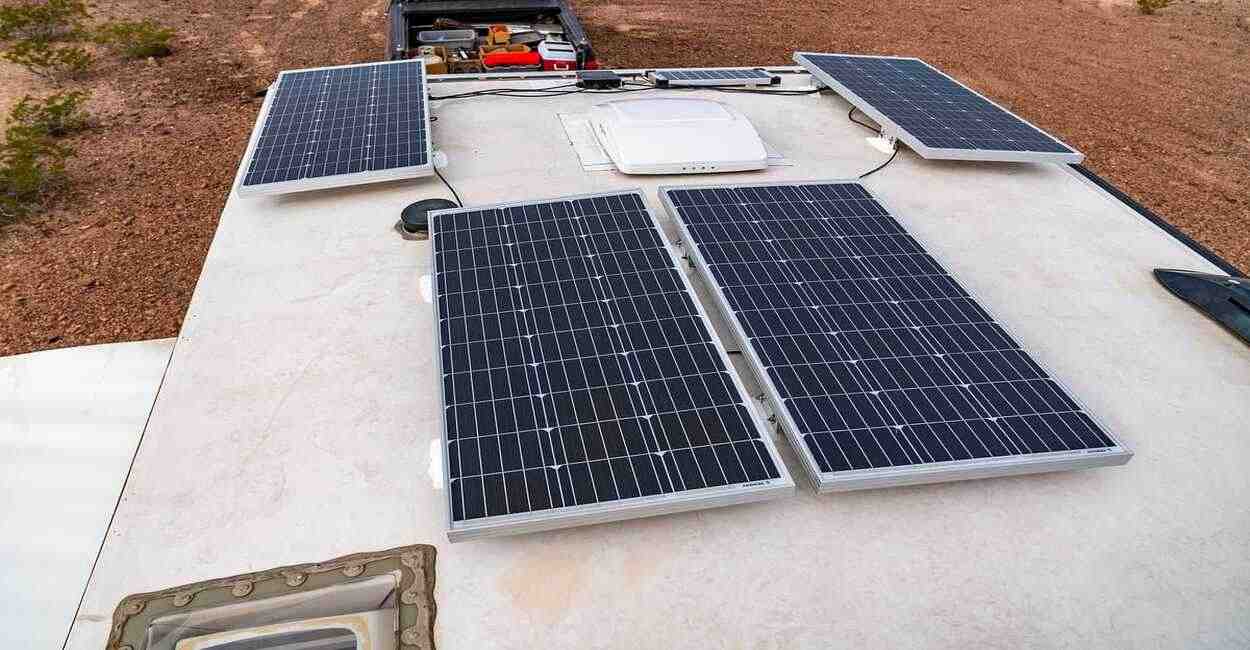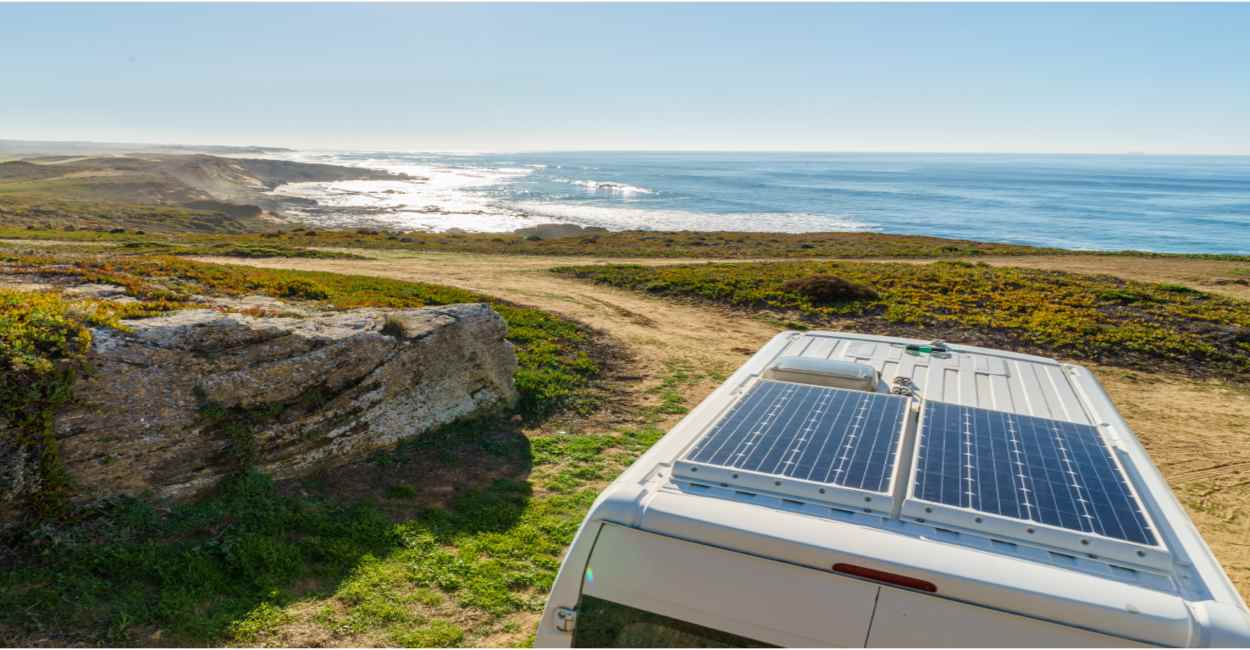RV Solar Panels - An Overview

You must have gone through RVs on the road that is constantly exposed to solar radiation.
The fixation of RV solar panels can be done to the roof with a fixed racking system designed especially for them. Since the roof constantly receives solar radiation, RV solar panels will be able to generate high amounts of electricity to power DC and AC loads while on the roads.
If we talk about the benefits of having RV solar panels, then the system helps eliminate the requirement of charging batteries that have to charge with an external power outlet and the need to use external diesel generators. Solar panels only ask for exposure to the sun to generate power all day long, as no objects are shading the modules.
Benefits Of RV Solar Panels
RV solar panels can be a great option to generate energy; the system delivers a great number of benefits. Some of them are:
Simple - No installation
One can make the installation and fix RV solar panels on the roof of the RV; this part is not mandatory. There is an option to have portable solar panels for RVs, which are placed around the vehicle facing the sun. Another option is to stick flexible solar panels for RV to the roof; the process does not require drilling holes in the roof.
Portability
RV solar panels are basically portable in nature and can be shifted from one place to another comfortably. With the migration, the system can constantly generate power on the road. One should be aware of the condition to never park in a shaded spot since your panels would not generate power or will do so at reduced performance.
Independence from the grid and power generators
Regular RVs eliminated the concept of campgrounds to charge deep-cycle batteries. Alternatively, they use external generators. Extreme noises are created by these generators and require fuel constantly. RV solar panels are the best solution to these problems since they only need sunlight to generate power and own the capability to work for 20 to 25 years.
What Types Of Solar Panels Are Used For RV’s?
Some RVs have certain problems that include ventilation shafts and other similar objects placed on the roof. These panels are used to limit the space required for the installation. Other RVs might not have flat roofs, making the installation a more challenging and tough part to accomplish.
To solve such types of problems, different types of solar panels can be fitted for RVs. These are the following:
Rigid or Traditional Solar Panels
There are two types of rigid solar panels for RVs:
The first one is monocrystalline silicon, and the second one is polycrystalline silicon.
These silicon-based panels are manufactured using the same source material but have different manufacturing processes and properties.
Monocrystalline Silicon
Monocrystalline silicon is the most powerful and efficient solar technology available for RVs. This technology is useful for homes and RVs. They are manufactured by using solar cells from a single silicon crystal process by the technique of Czochralski.
Monocrystalline silicon RV solar panels cost around $1.25/W, and the highest recorded efficiency for monocrystalline silicon is recorded at 25.4%. This technology is one of the best technologies preferred for yielding the highest possible power output.
The performance of these modules is affected by a temperature coefficient of nearly -0.38%/ºC. The installation usually requires drilling holes and using a fixing rack for the roof. The portable design of the same is also available.
Polycrystalline Silicon
Polycrystalline silicon is molded by melting various silicon crystals together, resulting in a solar cell with slightly higher impurities and lower efficiency. The cost of the final product is very low.
The highest efficiency for polycrystalline silicon is recorded at 24.4%, while its cost is only $1.00/W, which is 10% less than monocrystalline silicon. These RV solar panels can be affected by temperature through a temperature coefficient of -0.39%/ºC.
Flexible Solar Panels
Thin-Film Amorphous Silicon
Amorphous silicon is a type of thin-film technology which was used since the 70s. This technology achieved its highest recorded conversion efficiency at 14.0%, but the cost of the product is as low as $0.69/W.
Amorphous silicon RV solar panels are resistant to high temperatures. They are only affected by a temperature coefficient of -0.234%/ºC. This technology has excellent workability when driving your RV in hot climates.
Monocrystalline Silicon
Monocrystalline silicon-based solar panels are not only used for traditional rigid solar panels. This technology has been modified and improved in the last decade. They follow the criterion to create flexible monocrystalline solar panels. This feature helps the module to get stuck to the roof without drilling holes to install racking.
The value of efficiency for this type of technology is close to the values of traditional monocrystalline technologies that rate at around 23% to 25%.

How Much Do Solar Panels For RV Cost?
We are all aware of the fact that RV solar is expensive… but how expensive is it, exactly?
The cost of the RV solar system is totally dependent on your needs and what your specific RV solar setup will look like. They can be customized as per the requirements and may not work for your RV. Generally, these types of systems cost around a hundred dollars ($500-$700) and go further the same at an increasing rate. As solar power becomes more and more common, prices have dropped.
However, one can take this opportunity to upgrade other portions of your RV’s system, like switching to lithium batteries, which can extend the life of the battery and lower your overall maintenance requirements, and along with this, they also add a bit more to the overall solar.
How Do RV Solar Panels Work?
When you are ready to spend the majority of your time camping or boondocking, solar panel systems are a useful addition to any RV. These panels are usually placed on the roof of your RV, which is the perfect place for the placing of panels to absorb energy from the sunlight that hits their cells. This energy is then converted into an electrical current, which is transferred through wires toward a charge controller.
The energy absorbed becomes DC electricity that charges your RV’s batteries to power devices, appliances, and anything else that uses electricity. This way, you can have working lights, a TV, and a running refrigerator from anywhere on the road!
How Much Solar Power Do I Need For My RV?
These days the solar power revolution has emerged a lot at the consumer level. One of the major properties of the solar panel is that apart from being “Green”, these modern solar panels are also efficient enough to reduce or sometimes eliminate the requirement of the RV’s for traditional gasoline or diesel-powered generators.
This might leave you wondering about how much solar power is needed to power the RV.
An average travel trailer utilizes 120 Amp Hours of solar power, whereas a fifth luxury wheel or Class A motorhome might need 240 to 360 Amp Hours of solar power to maintain its arsenal of appliances.
The 5 Basic Components Of An RV Solar Power System
1. Solar panels
Solar panels capture photons, which are the tiny particles of light present in the photovoltaic cells that make up the solar panels. The meaning of photovoltaic is converting sunlight into electricity. Many cells are linked together to make a solar panel. You’ll need to calculate how many solar panels you’ll need. This can be done through some simple calculations.
2. A charge controller:
Overcharging the batteries will shorten the lifespan of the system. A charge controller prevents the solar panel from overcharging the battery. It regulates the voltage and current coming from the solar panels and transmits them to the battery.
3. An inverter
The inverter changes 12-volt DC power from your battery into 120-volt AC power that can be further used in appliances such as microwaves, coffee makers, or TV. A solar power system without an inverter can allow your 12-volt DC power system to supply appliances like your lights, water pump, fan, and furnace.
4. A transfer switch
The transfer switch is sometimes built inside the inverter and can also be purchased separately. A transfer switch automatically switches power going to the RV electrical panel between two incoming sources of AC power.
5. The battery
The electricity produced by solar panels is stored in a battery so that it can be used later when required. There are three types of batteries: AGM Lead Acid, Flooded Cell Lead Acid, and LifePO Lithium.
One can easily make the calculations of the number of batteries required by figuring out the wattage of each appliance you’ll be using by how long you’ll be using it.

How To Hook Up Solar Panels To RV Batteries
- Mount your solar panels on the roof of your RV.
- Place the charge controller inside the RV as close to your batteries as possible.
- Make the wiring from the solar panels into the RV to the charge controller. To avoid unnecessary holes in your RV, you could run your wiring through a refrigerator vent or through the holes where the plumbing enters the RV.
- Install a fuse or circuit breaker on the wires from the solar panels to the charge controller.
- The fuse should be larger than the charge controller’s rated current. This will help you to protect your electrical system from fault.
- Connect the charge controller wires to your battery bank (or to your inverter). Always follow the instructions of the manufacturer while making the installation complete.
- Install your inverter close to your batteries and away from heat, corrosive battery gasses, and other damaging elements. Make the connection of the inverter to the battery. Always connect to the negative post first.
- Now, the system is fully installed, but the RV solar panels are not connected to the charge controller. Before making the final connection, it’s important to double-check all wiring.
- After checking everything out, you can plug the solar panels into the charge controller. The best way to perform the task is at night or else to cover the solar panels with a blanket to prevent a spark.
Conclusion
RV solar power is the best thing that you will add to your RVer life. You will have perfected the already good experience and it will give you the freedom to venture more in life. As highlighted above, renewable energy power is not only friendly to you but also to the environment.

